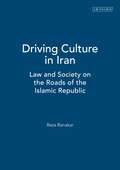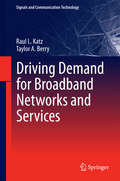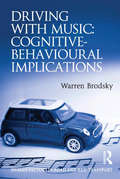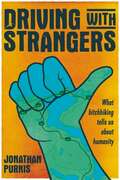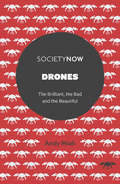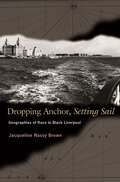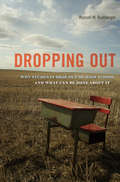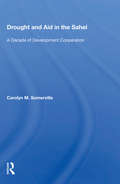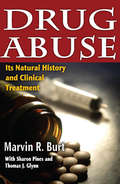- Table View
- List View
Driving Culture in Iran: Law and Society on the Roads of the Islamic Republic (International Library of Iranian Studies)
by Reza BanakarReza Banakar is Professor and Director of Research in the Sociology of Law Department at Lund University. He has previously held the positions of Professor of Socio-Legal Studies at the Department of Advanced Legal Studies at the University of Westminster and Research Fellow at the Centre for Socio-Legal Studies at the University of Oxford. He is the author of Normativity in Legal Sociology (2015) and Law and Social Theory (2010, 2013).
Driving Culture in Iran: Law and Society on the Roads of the Islamic Republic
by Reza BanakarIran has one of the highest rates of road traffic accidents worldwide and according to a recent UNICEF report, the current rate of road accidents in Iran is 20 times more than the world average. Using extensive interviews with a variety of Iranians from a range of backgrounds, this book explores their dangerous driving habits and the explanations for their disregard for traffic laws. It argues that Iranians' driving behaviour is an indicator of how they have historically related to each other and to their society at large, and how they have maintained a form of social order through law, culture and religion. By considering how ordinary Iranians experience the traffic problem in their cities and how they describe traffic rules, laws, authorities and the rights of other citizens, Driving Culture in Iran provides an original and valuable insight into Iranian legal, social and political culture.
Driving Demand for Broadband Networks and Services (Signals and Communication Technology)
by Raul L. Katz Taylor A. BerryThis book examines the reasons why various groups around the world choose not to adopt broadband services and evaluates strategies to stimulate the demand that will lead to increased broadband use. It introduces readers to the benefits of higher adoption rates while examining the progress that developed and emerging countries have made in stimulating broadband demand. By relying on concepts such as a supply and demand gap, broadband price elasticity, and demand promotion, this book explains differences between the fixed and mobile broadband demand gap, introducing the notions of substitution and complementarity between both platforms. Building on these concepts, ‘Driving Demand for Broadband Networks and Services’ offers a set of best practices and recommendations aimed at promoting broadband demand. The broadband demand gap is defined as individuals and households that could buy a broadband subscription because they live in areas served by telecommunications carriers but do not do so because of either economic, limited awareness, or lack of digital literacy reasons. This grouping represents a range from 30% of the population in the US, 40% in Germany, and over 80% in most emerging countries. Research indicates that broadband usage is critical for social development, economic performance, and overall welfare and so it behoves governments to encourage demand. This study is the first of its kind to address the demand side of broadband diffusion, incorporating an economic analysis while offering real world examples of policies and initiatives that have successfully spurred demand in developed and emerging markets alike. This book is intended for policy makers, managers of telecommunications and other technology companies, as well as academics and graduate students in the areas of public policy, economic development, and technology management. This book is an eye-opener for policy makers. Traditionally ICT policy has focused on the supply side. Katz and Berry develop great ideas to leapfrog Internet penetration from the demand side, where the value of the Internet is. - Diego Molano Vega, Minister of Information Technologies and Communications of Colombia This book is an instant classic. It brilliantly and convincingly lays out the case why dealing with inadequate internet penetration has moved from the creation of supply to one of encouraging demand. It provides an information-rich and well-written presentation of the factors holding back people from becoming users, and offers a hugely valuable survey of the various programs around the world to make the broadband internet truly useful to people everywhere. It is the kind of book writers in this field will use constantly. - Eli Noam, Professor of Finance and Economics, Columbia Business School This new study by Katz and Berry examines the rationale for national broadband plans and the evidence for their success in driving demand. It presents the latest data on broadband in a range of case study countries, and provides best practice advice for policy-makers and development practitioners. - Dr Tim Kelly, Lead ICT Policy Specialist, World Bank
Driving Justice, Equity, Diversity, and Inclusion
by Kristina KohlNavigating the volatility, uncertainty, complexity, and ambiguity (VUCA) characterizing the business world in the 21st century requires a new paradigm focused on an integrated bottom line – planet, people, and profit (PPP). Global trends include resource scarcity and growing inequities in income, wealth, education, and healthcare. Stakeholders are demanding that organizations address systemic barriers to promote justice and equity within organizations and across broader social systems. Transformational change requires leadership to analyze internal and external systems through a social and environmental justice lens. Despite a growing focus on justice, equity, diversity, and inclusion, the imbalance of power remains within our institutions, organizations, and social systems. To move the needle, leaders can turn to Driving Justice, Equity, Diversity, and Inclusion, which explains developing a North Star vision and creating a strategy to redesign organizational process and systems, as well as leveraging tools for data-driven decision-making. It presents a framework to build an inclusive organization as well as a model to engage and support senior and middle management beginning the process of capacity building and systemic change. By layering in AI and other technologies to support data-driven decision-making, the book guides leaders in navigating their organization’s journey along the maturity continuum to achieve their North Star vision of becoming a just and equitable organization. The book also helps managers to Assess ecosystems and organizational systems that justice, equity, diversity, and inclusion impact Take a deeper dive into transformational and operational components to gain insights on the deep systemic realignment of the North Star vision Identify and engage with diverse stakeholders to gain perspective and understand issues crucial for transformative change Leverage people-centered design to create a process promoting diversity of voices and to better align outcomes with shared organizational vision Use data to drive decision-making and reduce bias by removing intuition from the decision-making process Leverage the book's frameworks to drive collaborative systemic change Adapt insights highlighted in multiple interviews with DEI practitioners Benefit from lessons learned and best practices featured in the book's case studies This book features a primer, which is a quick reference guide to key terms, concepts, and definitions. It helps to define justice, equity, diversity, inclusion, and other key terms, such as unconscious bias, stereotypes, and microaggressions. It also features a toolkit, which includes checklists to help managers lead organizations to realize their own North Star vision.
Driving Justice, Equity, Diversity, and Inclusion
by Kristina KohlNavigating the volatility, uncertainty, complexity, and ambiguity (VUCA) characterizing the business world in the 21st century requires a new paradigm focused on an integrated bottom line – planet, people, and profit (PPP). Global trends include resource scarcity and growing inequities in income, wealth, education, and healthcare. Stakeholders are demanding that organizations address systemic barriers to promote justice and equity within organizations and across broader social systems. Transformational change requires leadership to analyze internal and external systems through a social and environmental justice lens. Despite a growing focus on justice, equity, diversity, and inclusion, the imbalance of power remains within our institutions, organizations, and social systems. To move the needle, leaders can turn to Driving Justice, Equity, Diversity, and Inclusion, which explains developing a North Star vision and creating a strategy to redesign organizational process and systems, as well as leveraging tools for data-driven decision-making. It presents a framework to build an inclusive organization as well as a model to engage and support senior and middle management beginning the process of capacity building and systemic change. By layering in AI and other technologies to support data-driven decision-making, the book guides leaders in navigating their organization’s journey along the maturity continuum to achieve their North Star vision of becoming a just and equitable organization. The book also helps managers to Assess ecosystems and organizational systems that justice, equity, diversity, and inclusion impact Take a deeper dive into transformational and operational components to gain insights on the deep systemic realignment of the North Star vision Identify and engage with diverse stakeholders to gain perspective and understand issues crucial for transformative change Leverage people-centered design to create a process promoting diversity of voices and to better align outcomes with shared organizational vision Use data to drive decision-making and reduce bias by removing intuition from the decision-making process Leverage the book's frameworks to drive collaborative systemic change Adapt insights highlighted in multiple interviews with DEI practitioners Benefit from lessons learned and best practices featured in the book's case studies This book features a primer, which is a quick reference guide to key terms, concepts, and definitions. It helps to define justice, equity, diversity, inclusion, and other key terms, such as unconscious bias, stereotypes, and microaggressions. It also features a toolkit, which includes checklists to help managers lead organizations to realize their own North Star vision.
Driving Performance through Learning: Develop Employees through Effective Workplace Learning
by Andy LancasterLearning and Development (L&D) professionals are uniquely placed in an organization to improve both individual employee performance as well as the overall performance of the business. To maximise the impact of learning, activities must be aligned with the goals of the organization and delivered in the flow of work so that performance improvement is continuous. The course can no longer be the default learning option and creative workplace solutions are now vital. Driving Performance through Learning shows L&D professionals how to identify business needs and leverage learning that drives performance improvement to enable an organization to achieve its objectives. Beginning with an exploration of the fast-changing organizational learning landscape Driving Performance through Learning covers everything from how to diagnose needs through performance consulting conversations, using data and metrics and tracking impact to designing agile solutions by leveraging technology, facilitating social collaboration and vibrant learning communities. There is also expert guidance on curating content, embedding coaching, valuing mistakes and adopting a more self-directed learning approach. This book also defines the key characteristics of the new learning organization and the emerging roles of the future-focussed L&D team and whether these new responsibilities should be developed in-house or outsourced. This is an essential handbook for all L&D professionals seeking to transform workplace learning and drive organizational performance.
Driving Performance through Learning: Develop Employees through Effective Workplace Learning
by Andy LancasterLearning and Development (L&D) professionals are uniquely placed in an organization to improve both individual employee performance as well as the overall performance of the business. To maximise the impact of learning, activities must be aligned with the goals of the organization and delivered in the flow of work so that performance improvement is continuous. The course can no longer be the default learning option and creative workplace solutions are now vital. Driving Performance through Learning shows L&D professionals how to identify business needs and leverage learning that drives performance improvement to enable an organization to achieve its objectives. Beginning with an exploration of the fast-changing organizational learning landscape Driving Performance through Learning covers everything from how to diagnose needs through performance consulting conversations, using data and metrics and tracking impact to designing agile solutions by leveraging technology, facilitating social collaboration and vibrant learning communities. There is also expert guidance on curating content, embedding coaching, valuing mistakes and adopting a more self-directed learning approach. This book also defines the key characteristics of the new learning organization and the emerging roles of the future-focussed L&D team and whether these new responsibilities should be developed in-house or outsourced. This is an essential handbook for all L&D professionals seeking to transform workplace learning and drive organizational performance.
Driving the Enterprise to Sustainable Excellence: A Shingo Process Overview
by Gerhard PlenertThis book presents a big-picture overview of the entire Shingo improvement process. It fully discusses the needs and benefits of the Shingo process, and what is required if you seek to execute the Shingo Model in your enterprise and focuses on creating an enduring organization-wide continuous improvement process. It gives the reader a discussion of the entire Shingo experience while the most existing books on the model are course specific. There are numerous discussions, conference talks, and webinars of why the Shingo process is beneficial, and what types of improvements can be achieved, but the crucial material has not been assembled in one concise book, giving the executive, manger, or supervisor an overview and understanding of what the Shingo experience entails. The main purpose of this book. It is for the executives who want to understand their role in supporting and leading middle management with its implementation. Many executives from developing countries all over the world are seeking a concise definition of what the Shingo model is, and this book functions as the perfect primer. Even those who have attended and implemented the lessons from the Shingo Institute's courses would find this book a benefit as it serves perfectly as backup and reference material. In addition, this book helps anyone who has started their journey with the Shingo model and may be confused about what to do and expect -- It gives them a vision of what the continuing journey will look like. The Shingo process is being taught at numerous universities and this book could indeed serve as the appropriate textbook or supplemental reading. Essentially, this book teaches an innovative and extremely successful approach to continuous improvement, referred to as the Shingo process. It is based on a set of universally accepted principles that are endorsed by improvement leaders such as Covey and companies such as Toyota. This book is not a detailed review or a replacement of the Shingo workshops. It is an overview of the entire Shingo process, starting with a discussion of the challenges that many of todays enterprises are experiencing. The author, in his role as a PhD in economics, has studied industries and has worked closely with many of them attempting to understand their weaknesses. Next, this book builds upon an understanding of these weaknesses. The book discusses how the over-all Shingo methodology fits into these organizations and highlights the benefits. The next step is then to discuss what requirements are necessary for an organization to get ready for a Shingo transformation. What are the steps that the organization needs to go through, and when will it know that it is ready to begin? The book briefly reviews the Shingo Insights and Principles and explains how the Shingo courses should be best utilized to facilitate the desired transformation. It suggests some alternative plans for over-all implementation based on the current state of the enterprise. It explains why there is no “one way” for successful implementation and how the implementation sequence needs to be customized. It also discusses the length of time needed for success and how this differs depending on the current enterprise environment. Lastly the book explains how the implementation and Shingo training is never finished. It is an on-going process and success is defined by internal improvements, not by some arbitrary external benchmark. The book is intended to be educational, thought provoking, entertaining in its stories and examples, and a guideline towards the development of a plan for continuous improvement. This book is filled with stories and examples, showing successful and not so successful implementations. The stories are used to highlight many of the pitfalls that have arisen and may arise for you and which can be avoided if the reader is aware of them and knows how to watch for them.
Driving the Enterprise to Sustainable Excellence: A Shingo Process Overview
by Gerhard PlenertThis book presents a big-picture overview of the entire Shingo improvement process. It fully discusses the needs and benefits of the Shingo process, and what is required if you seek to execute the Shingo Model in your enterprise and focuses on creating an enduring organization-wide continuous improvement process. It gives the reader a discussion of the entire Shingo experience while the most existing books on the model are course specific. There are numerous discussions, conference talks, and webinars of why the Shingo process is beneficial, and what types of improvements can be achieved, but the crucial material has not been assembled in one concise book, giving the executive, manger, or supervisor an overview and understanding of what the Shingo experience entails. The main purpose of this book. It is for the executives who want to understand their role in supporting and leading middle management with its implementation. Many executives from developing countries all over the world are seeking a concise definition of what the Shingo model is, and this book functions as the perfect primer. Even those who have attended and implemented the lessons from the Shingo Institute's courses would find this book a benefit as it serves perfectly as backup and reference material. In addition, this book helps anyone who has started their journey with the Shingo model and may be confused about what to do and expect -- It gives them a vision of what the continuing journey will look like. The Shingo process is being taught at numerous universities and this book could indeed serve as the appropriate textbook or supplemental reading. Essentially, this book teaches an innovative and extremely successful approach to continuous improvement, referred to as the Shingo process. It is based on a set of universally accepted principles that are endorsed by improvement leaders such as Covey and companies such as Toyota. This book is not a detailed review or a replacement of the Shingo workshops. It is an overview of the entire Shingo process, starting with a discussion of the challenges that many of todays enterprises are experiencing. The author, in his role as a PhD in economics, has studied industries and has worked closely with many of them attempting to understand their weaknesses. Next, this book builds upon an understanding of these weaknesses. The book discusses how the over-all Shingo methodology fits into these organizations and highlights the benefits. The next step is then to discuss what requirements are necessary for an organization to get ready for a Shingo transformation. What are the steps that the organization needs to go through, and when will it know that it is ready to begin? The book briefly reviews the Shingo Insights and Principles and explains how the Shingo courses should be best utilized to facilitate the desired transformation. It suggests some alternative plans for over-all implementation based on the current state of the enterprise. It explains why there is no “one way” for successful implementation and how the implementation sequence needs to be customized. It also discusses the length of time needed for success and how this differs depending on the current enterprise environment. Lastly the book explains how the implementation and Shingo training is never finished. It is an on-going process and success is defined by internal improvements, not by some arbitrary external benchmark. The book is intended to be educational, thought provoking, entertaining in its stories and examples, and a guideline towards the development of a plan for continuous improvement. This book is filled with stories and examples, showing successful and not so successful implementations. The stories are used to highlight many of the pitfalls that have arisen and may arise for you and which can be avoided if the reader is aware of them and knows how to watch for them.
Driving With Music: Cognitive-Behavioural Implications (Human Factors in Road and Rail Transport)
by Warren BrodskyThis book, the first full-length text on the subject, explores the everyday use of music listening while driving a car. It presents the relationship between cars and music in an effort to understand how music behaviour in the car can either enhance driver safety or place the driver at increased risk of accidents. A great deal of work has been done to investigate and reduce driver distraction and inattention, but this book is the first to focus on in-cabin aural backgrounds of music as a contributing factor to human error and traffic violations. Driving With Music begins by outlining the automobile, its relationship to society, and the juxtaposition of music with the automobile as a complete package. It then highlights concepts from the fields of music perception and cognition, and, within this framework, looks at the functional use of background music in our everyday lives. Driver music behaviours - both adaptive and maladaptive - are explored, with the focus on contradictions and ill-effects of in-car music listening. To conclude, implications, applications and countermeasures are suggested.
Driving with strangers: What hitchhiking tells us about humanity
by Jonathan PurkisAt a time of climate crisis, isolation and social breakdown, Driving with strangers is a manifesto to alter how we think about our place in the world. Veteran hitchhiker and lifelong aficionado of hitchhiking culture, Purkis journeys through the history of hitchhiking to explore the unique opportunities for cooperation, friendship, sustainability and openness that it represents.Join Purkis on the kerbside, in search of Woody Guthrie as he examines the politics of the travelling song, deep on a Russian hitch-hiking expedition, or considering the politics of travel and risk on the ‘Highway of Tears’ in British Columbia, Canada. The reader is taken on a panoramic road trip through a century of hitchhiking across different decades, countries and continents.Purkis, a self-styled ‘vagabond sociologist’, is the perfect passenger to accompany you on a journey away from isolation, social distancing, closed borders and into a better understanding of why and how strangers can enrich our lives.
Driving with strangers: What hitchhiking tells us about humanity
by Jonathan PurkisAt a time of climate crisis, isolation and social breakdown, Driving with strangers is a manifesto to alter how we think about our place in the world. Veteran hitchhiker and lifelong aficionado of hitchhiking culture, Purkis journeys through the history of hitchhiking to explore the unique opportunities for cooperation, friendship, sustainability and openness that it represents.Join Purkis on the kerbside, in search of Woody Guthrie as he examines the politics of the travelling song, deep on a Russian hitch-hiking expedition, or considering the politics of travel and risk on the ‘Highway of Tears’ in British Columbia, Canada. The reader is taken on a panoramic road trip through a century of hitchhiking across different decades, countries and continents.Purkis, a self-styled ‘vagabond sociologist’, is the perfect passenger to accompany you on a journey away from isolation, social distancing, closed borders and into a better understanding of why and how strangers can enrich our lives.
Drogenkonsum und Drogenpolitik: Deutschland und die Niederlande im Vergleich
by Karl-Heinz ReubandEs zählt zu den Merkwürdigkeiten der neueren Diskussion, wie sehr das Drogenphänomen als länderübergreifendes Problem wahrgenommen wird und wie wenig gleichzeitig über die Drogenproblematik und Drogenpolitik in anderen Ländern bekannt ist. Bloße Annahmen, die wie gesicherte wis senschaftliche Erkenntnisse behandelt und nicht mehr hinterfragt werden, bestimmen die Diskussion. Wohl nirgends wird dies deutlicher als im Fall der Bundesrepublik Deutschland und der Niederlande. Beide Länder verfol gen gegenüber dem Drogengebrauch eine unterschiedliche Strategie: Wäh rend in der Bundesrepublik der Besitz und Erwerb von Cannabis strafrecht lich geahndet wird, wird in den Niederlanden eine Politik der Tolerierung, ja gar der gesellschaftlichen Akzeptanz betrieben. Aus Sicht vieler, wenn nicht gar der meisten bundesdeutschen Autoren, muß eine derartige liberale Politik zwangsläufig den Drogengebrauch und drogenbedingte Probleme begünstigen. Doch aus Sicht vieler holländischer Autoren bewirkt sie genau das Gegenteil: eine Abnahme der Konsumentenzahlen, eine Trennung des Marktes für weiche und harte Drogen und eine Reduktion drogenbedingter Probleme. Die Selbstverständlichkeit, mit der in den beiden Ländern die eigenen Deutungen vorgebracht werden, ist bemerkenswert. Daß sie im Wider spruch zu den Deutungen in anderen Ländern -gar des Nachbarlande- stehen, wird in der Regel nicht zur Kenntnis genommen. Weder gibt es eine Diskussion über die unterschiedlichen "Realitäts"beschreibungen noch deren Überprüfung anhand empirischer Belege. Maßgeblich verantwortlich für diese Situation ist die verbreitete Neigung, den Drogengebrauch auch dort primär unter einer wertgeladenen Perspektive zu sehen, wo es um Sachaussagen gehl Argumente moralischer und politischer Natur ersetzen unter diesen Umständen die wissenschaftliche Auseinandersetzung.
Drogue et Civilisation: Refus Social ou Acceptation: Entretiens de Rueil
by Sam StuartDrogue et Civilisation
Drones: The Brilliant, the Bad and the Beautiful (SocietyNow)
by Andy MiahAgainst the backdrop of an increasingly dynamic world, driven by rapid digital innovation and technological advances, drones are becoming prolific within society. In this book, Andy Miah delivers a comprehensive analysis of the wide-reaching applications of drones, as well as a critical interrogation of the social, cultural and moral issues that they provoke. Delving into philosophical discussions about the implications of drone technology, this book shines a light on their real-world applications, the challenges they pose, and what they reveal about the human condition, when faced with a future of autonomous, intelligent robots.
Drones: The Brilliant, the Bad and the Beautiful (SocietyNow)
by Andy MiahAgainst the backdrop of an increasingly dynamic world, driven by rapid digital innovation and technological advances, drones are becoming prolific within society. In this book, Andy Miah delivers a comprehensive analysis of the wide-reaching applications of drones, as well as a critical interrogation of the social, cultural and moral issues that they provoke. Delving into philosophical discussions about the implications of drone technology, this book shines a light on their real-world applications, the challenges they pose, and what they reveal about the human condition, when faced with a future of autonomous, intelligent robots.
Drones in Smart-Cities: Security and Performance
by Fadi Al-TurjmanDrones in Smart-Cities: Security and Performance is the first book dedicated to drones in smart cities, helping address the many research challenges in bringing UAVs into practice. The book incorporates insights from the latest research in Internet of Things, big data, and cloud computing, 5G, and other communication technologies. It examines the design and implementation of UAV, focusing on data delivery, performability, and security. Intended for researchers, engineers, and practitioners, Drones in Smart-Cities: Security and Performance combines the technical aspects with academic theory to help implement the smart city vision around the globe.Addresses UAV and IoT for smart cities applicationsExamines topics as UAV safety, challenges, localization methods. QoS, simulation tools, and moreCollect the relevant knowledge in one resource, saving research time and effort
A Drop of Light: Educating for the A-ha Moment
by Liz AttwellA-ha!Working through a topic or question, a shaft of sudden inspiration hits. The cloud of fragmented ideas and thoughts clear as a whole picture begins to form coherently in your mind. What you have now worked out – in an unexpected, exciting eureka moment – will stay with you forever. All teachers seek this experience for their students. Liz Attwell explores theories of education to argue that traditional teaching, ‘filling buckets’, must be replaced by dynamic, progressive teaching that promotes active learning – not just ‘lighting a fire’, but knowing how to lay the sticks and finding the matches too. This progressive approach seeks to create a basis for inner awakening and original insight, in order for students ultimately to come to their own a-ha moments.In A Drop of Light, Liz Attwell presents her original research into the phenomenon of a-ha moments, offering a theoretical background as well as practical advice to give teachers the tools, lesson plans, anecdotes and inspiration to bring living thinking to their own classrooms. Goethe’s approach and Rudolf Steiner’s pedagogical ideas make an important contribution, but Attwell advises that teachers following Steiner’s philosophy should enter into dialogue with educators from other backgrounds. Working together, enlightened teachers around the world can help schools and colleges to become true learning communities.
Dropping Anchor, Setting Sail: Geographies of Race in Black Liverpool
by Jacqueline Nassy BrownThe port city of Liverpool, England, is home to one of the oldest Black communities in Britain. Its members proudly date their history back at least as far as the nineteenth century, with the global wanderings and eventual settlement of colonial African seamen. Jacqueline Nassy Brown analyzes how this worldly origin story supports an avowedly local Black politic and identity--a theme that becomes a window onto British politics of race, place, and nation, and Liverpool's own contentious origin story as a gloriously cosmopolitan port of world-historical import that was nonetheless central to British slave trading and imperialism. This ethnography also examines the rise and consequent dilemmas of Black identity. It captures the contradictions of diaspora in postcolonial Liverpool, where African and Afro-Caribbean heritages and transnational linkages with Black America both contribute to and compete with the local as a basis for authentic racial identity. Crisscrossing historical periods, rhetorical modes, and academic genres, the book focuses singularly on "place," enabling its most radical move: its analysis of Black racial politics as enactments of English cultural premises. The insistent focus on English culture implies a further twist. Just as Blacks are racialized through appeals to their assumed Afro-Caribbean and African cultures, so too has Liverpool--an Irish, working-class city whose expansive port faces the world beyond Britain--long been beyond the pale of dominant notions of authentic Englishness. Dropping Anchor, Setting Sail studies "race" through clashing constructions of "Liverpool."
Dropping Anchor, Setting Sail: Geographies of Race in Black Liverpool (PDF)
by Jacqueline Nassy BrownThe port city of Liverpool, England, is home to one of the oldest Black communities in Britain. Its members proudly date their history back at least as far as the nineteenth century, with the global wanderings and eventual settlement of colonial African seamen. Jacqueline Nassy Brown analyzes how this worldly origin story supports an avowedly local Black politic and identity--a theme that becomes a window onto British politics of race, place, and nation, and Liverpool's own contentious origin story as a gloriously cosmopolitan port of world-historical import that was nonetheless central to British slave trading and imperialism. This ethnography also examines the rise and consequent dilemmas of Black identity. It captures the contradictions of diaspora in postcolonial Liverpool, where African and Afro-Caribbean heritages and transnational linkages with Black America both contribute to and compete with the local as a basis for authentic racial identity. Crisscrossing historical periods, rhetorical modes, and academic genres, the book focuses singularly on "place," enabling its most radical move: its analysis of Black racial politics as enactments of English cultural premises. The insistent focus on English culture implies a further twist. Just as Blacks are racialized through appeals to their assumed Afro-Caribbean and African cultures, so too has Liverpool--an Irish, working-class city whose expansive port faces the world beyond Britain--long been beyond the pale of dominant notions of authentic Englishness. Dropping Anchor, Setting Sail studies "race" through clashing constructions of "Liverpool."
Dropping Out: Why Students Drop Out of High School and What Can Be Done About It
by Russell W. RumbergerThe vast majority of kids in the developed world finish high school—but not in the United States. More than a million kids drop out every year, around 7,000 a day, and the numbers are rising. Dropping Out offers a comprehensive overview by one of the country’s leading experts, and provides answers to fundamental questions: Who drops out, and why? What happens to them when they do? How can we prevent at-risk kids from short-circuiting their futures? Students start disengaging long before they get to high school, and the consequences are severe—not just for individuals but for the larger society and economy. Dropouts never catch up with high school graduates on any measure. They are less likely to find work at all, and more likely to live in poverty, commit crimes, and suffer health problems. Even life expectancy for dropouts is shorter by seven years than for those who earn a diploma. Rumberger advocates targeting the most vulnerable students as far back as the early elementary grades. And he levels sharp criticism at the conventional definition of success as readiness for college. He argues that high schools must offer all students what they need to succeed in the workplace and independent adult life. A more flexible and practical definition of achievement—one in which a high school education does not simply qualify you for more school—can make school make sense to young people. And maybe keep them there.
Drought And Aid In The Sahel: A Decade Of Development Cooperation
by Carolyn M. SomervilleThe 1968-1974 drought in the Sahel was an unprecedented catastrophe for the region, causing extensive crop failures, loss of human and animal populations, political instability, and the destruction of social and cultural structures. The response of the world to the catastrophe began with food aid donations from the Western nations and led to the fo
Drought And Aid In The Sahel: A Decade Of Development Cooperation
by Carolyn M. SomervilleThe 1968-1974 drought in the Sahel was an unprecedented catastrophe for the region, causing extensive crop failures, loss of human and animal populations, political instability, and the destruction of social and cultural structures. The response of the world to the catastrophe began with food aid donations from the Western nations and led to the fo
Drought and Water Scarcity in the UK: Social Science Perspectives on Governance, Knowledge and Outreach (Global Challenges in Water Governance)
by Kevin GreckschThis book presents a social science perspective on drought and water scarcity in the UK. It puts forward a narrative of how different stakeholders manage drought and water scarcity, how they generate and manage knowledge and how power relationships between stakeholders shape drought and water scarcity management. The book begins with an analysis and critique of all water resources management plans produced by English and Welsh water supply companies for the period 2014-2019 and introduces a novel typology for drought management options. It then moves on to discuss the effect of drought and water scarcity on businesses and production processes as well as how knowledge about drought and water scarcity is generated, by whom and for what purpose. Ultimately the book argues for the urgent need to engage people in the UK about water issues and offers a novel perspective on how to communicate and engage with drought research.
Drug Abuse: Its Natural History and Clinical Treatment
by Marvin R. Burt Sharon Pines Thomas J. GlynnThe success or failure of drug treatment programs have long been evaluated by assessing the clients' progress while in treatment and their status upon completion. This approach does not provide a complete assessment or an adequate picture of treatment outcomes over time. A comprehensive evaluation of the success or failure of treatment should also include client status in the years following treatment for a fair assessment of the long-term efficacy of any drug-treatment program. What happens to former clients who left treatment? What influence did the treatment have on their lives? These are the questions that Marvin R. Burt seeks to answer with the follow-up studies included in this book. By selecting samples of former clients treated by two of the largest drug treatment agencies in the U.S. and control groups, Burt compares client behavior in terms of drug abuse, criminal activity, and socioeconomic productivity before, immediately following, and well after treatment. The findings in this book challenge many common assumptions about drug treatment programs. Burt finds larger than expected positive behavioral changes in clients regardless of treatment duration or type, and demographic or background characteristics. Whether the results are attributable to the clients' maturation, commitment to change, or a reduction in the availability of drugs, the positive results of treatment are encouraging. This volume provides valuable insight into the natural history of drug abuse and outcomes for client groups.
